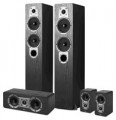Sensitivity
Speaker sensitivity.
This characteristic is indicated on the basis of how loud the acoustics are capable of producing when a signal of a certain standard power is applied to it. Simply put, the higher the sensitivity of the speaker, the louder it will sound at the same output power of the amplifier. Thus, sensitive acoustics can be effectively used even in combination with relatively low-power "amplifiers". On the other hand, low sensitivity also has its advantages: it allows you to achieve a more uniform frequency response and reduces the likelihood of overloading the amplifier. In the least sensitive modern speakers, this indicator
does not exceed 84 dB, in the most sensitive it is
95 – 96 dB or
more.
Note that in fact, you have to pay attention to this parameter when acoustics are planned to be used with a separately selected power amplifier. Therefore, for active systems (see "Type"), sensitivity is purely a reference value, and, usually, it can be ignored when choosing.
Crossover frequency
The crossover frequency provided in the speaker design.
A crossover is installed exclusively in a multi-band model (see "Number of Bands"). This is an electronic filter that ensures the division of the incoming audio signal into separate frequency ranges and directs each range to "its" set of speakers. And the crossover frequency shows where the boundary between these ranges lies. If there are more than two bands, there will be several such boundaries: for example, for a four-band system it may be specified "0.15 / 0.8 / 2.8 kHz" or "0.12 / 1 / 3.8".
In most cases, this parameter has mainly a reference value: the frequencies of the built-in crossover are selected to match the operating characteristics of the speakers installed in the speaker system.
Front
Rated power of one front speaker. See "Total Power Rating" below for details on power rating. Here we note that the higher the power, the louder the system component can sound — of course, with a properly selected amplifier. In addition, this parameter is very important for matching with the amplifier: it is desirable that the output power on the corresponding amplifier channel be less than the power of the speaker. If the incoming signal is more powerful, distortions in the sound and even damage to the speakers are possible, and if it is weaker, then the sound volume will decrease (in other words, it will not be possible to use the full potential of the acoustics), but this moment will be critical only for listening at maximum volume.
Rear
Rated output of the rear speaker. See "Front" above for details on power rating.
Centre
Rated power of the centre speaker. See "Front" above for details on power rating.
Maximum amplifier power
The highest power rating of an amplifier that the loudspeakers can handle safely. Too much input power can damage the speakers, so when connecting, make sure that the amplifier's characteristics do not exceed the capabilities of the speakers. It is worth noting that this parameter may be slightly higher than the total nominal power of the acoustics (see below), since in this case we are only talking about the safety of the equipment, and not about the absence of distortion in the sound.
Total rated power
The total rated power of all speaker components, in other words, the sum of the powers of all speakers. As a nominal one, they usually indicate the highest average (rms) power at which acoustics can operate for a long time without overloads and damage. In this case, individual power surges can significantly exceed this value, however, it is the rated power that is the main characteristic of any speaker.
First of all, the sound volume depends on this characteristic: the more powerful the speakers, the louder the sound they can produce if there is a suitable amplifier. In addition, in passive and passive-active models, compatibility with an external amplifier also depends on the power: the output power of the “amplifier” should not exceed the power of the acoustics connected to it, otherwise overloads and even breakdowns are possible.
Detailed recommendations regarding the choice of speakers for power for a particular situation can be found in special sources. However, in general, an indicator of up to
100 W by the standards of modern acoustics is considered quite modest,
100 – 200 W — average,
200 – 300 W — above average, and the most powerful sets give out
up to 500 W or even
more.
In conclusion, we note two more nuances. Firstly, when comparing different systems according to this ch
...aracteristic, one must also take into account the sound format in which they work. In particular, if there is a subwoofer, it can account for a significant part of the total power — up to half or more. As a result, for example, a 2.1 set of 50 W with a 20-watt subwoofer at the main frequencies will not be able to pull out the same volume as a 40-watt 2.0 system: in the first case, each main channel will have only 15 watts, in the second — 20 watts. Secondly, in multichannel systems, the total power can be distributed among the channels in different proportions; so, say, two 5.1 systems with the same total power can differ markedly in front and rear balance at maximum volume.Front
The range of audio frequencies that the front speaker can reproduce. See "Total Frequency Range" below for details on this setting.
Rear
The range of audio frequencies that the rear speaker is capable of reproducing. See "Total Frequency Range" below for details on this setting.

